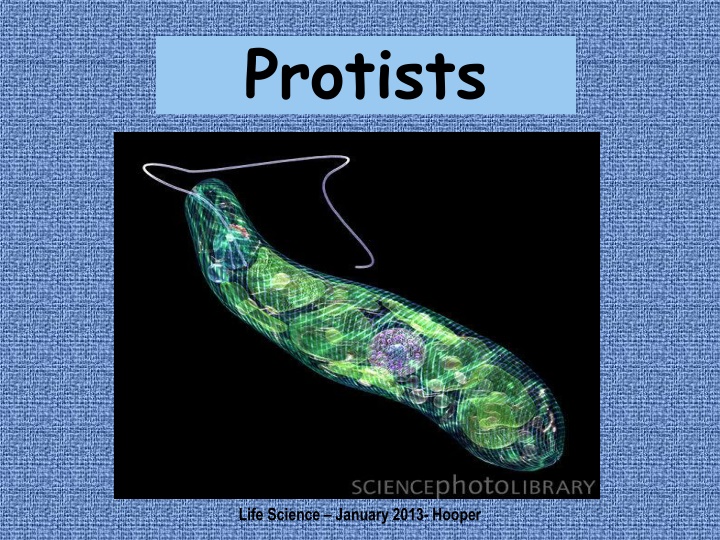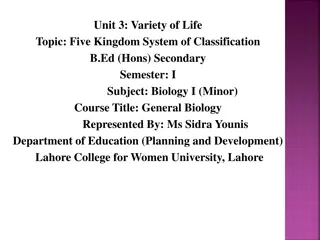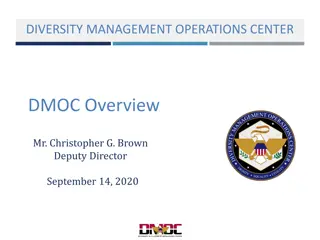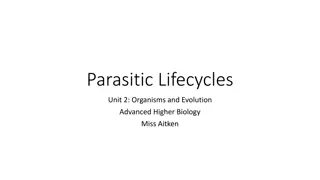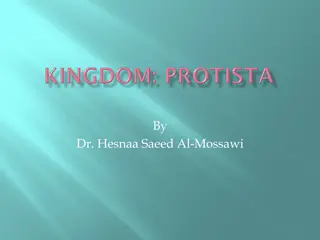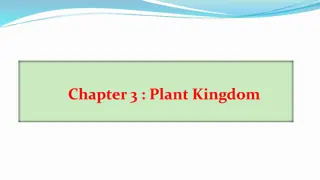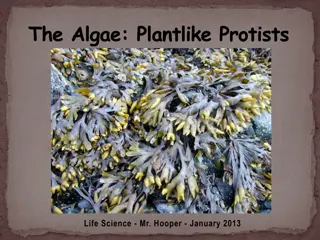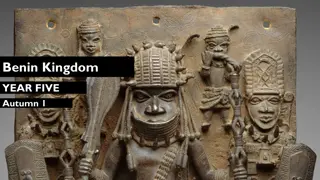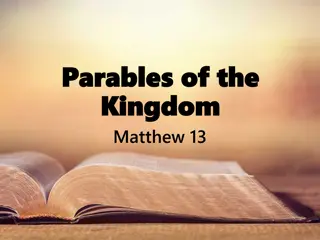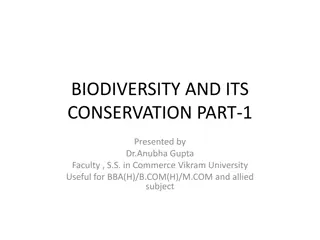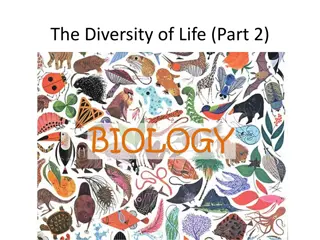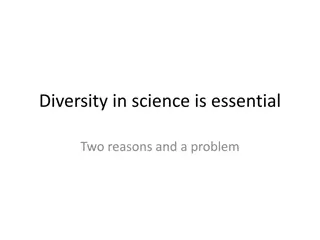Exploring the World of Protists: A Kingdom of Diversity
Protists are eukaryotes that cannot be classified as plants, animals, or fungi. They thrive in moist environments and showcase a remarkable diversity within the Kingdom Protista. From animal-like protozoa to plant-like autotrophs and fungus-like heterotrophs, this kingdom contains a wide array of unicellular and multicellular organisms, each with unique characteristics and lifestyles.
Download Presentation

Please find below an Image/Link to download the presentation.
The content on the website is provided AS IS for your information and personal use only. It may not be sold, licensed, or shared on other websites without obtaining consent from the author.If you encounter any issues during the download, it is possible that the publisher has removed the file from their server.
You are allowed to download the files provided on this website for personal or commercial use, subject to the condition that they are used lawfully. All files are the property of their respective owners.
The content on the website is provided AS IS for your information and personal use only. It may not be sold, licensed, or shared on other websites without obtaining consent from the author.
E N D
Presentation Transcript
Protists Euglena flagellate protozoan Life Science January 2013- Hooper
What is a Protist? Protists are eukaryotes (organisms whose cells have a nucleus) that cannot be classified as plants, animals, or fungi. Additionally, all protists live in moist surroundings.
A Kingdom of Diversity Diversity is the word that best describes Kingdom Protista. This kingdom contains organisms that are unicellular and organisms that are multicellular. It is the Odds and Ends Kingdom. Protists can be heterotrophs, autotrophs, or both. Trypanosoma brucei Some protists are motile and some are not. Tsetse fly
Animal-Like Protists Protozoan: one-celled animal-like protists. They are heterotrophs. Most protozoa are able to move . Amoeba proteus Protozoa include: 1. Sarcodines 2. Ciliates 3. Flagellates 4. Parasitic protozoa http://www.sciencephoto.com/image/100822/530wm/C0036596-Proteus_amoeba,_light_micrograph-SPL.jpg
Plantlike Protists LM of mixed diatoms Dinoflagellate, SEM http://www.sciencephoto.com/media/15785/enlarge Plantlike Protists autotrophs with a cell wall. 1. Diatoms 2. Dinoflagellates 3. Euglenoids 4. Red, Green, and Brown Algae http://www.sciencephoto.com/media/364891/enlarge
Funguslike Protists The funguslike protists are heterotrophs that have cell walls and use spores to reproduce. The funguslike protists include the slime molds, water molds, and downy mildews.
Protozoa - Sarcodines File:Trophozoites of Entamoeba histolytica with ingested erythrocytes.JPG Entamoeba histolytica A disease causing amoeba in humans. This amoeba can bore into the intestinal wall and enter the bloodstream and may cause liver abscesses. http://www.infovisual.info/02/003_en.html http://en.wikipedia.org/wiki/File:Trophozoites_of_Entamoeba_histolytica_with_ingested_erythrocytes.JPG
Protozoa - Ciliates Paramecium protozoa, light micrograph Paramecium bursaria A freshwater protist that moves with cilia. This paramecium has numerous autotrophic algae living in its cytoplasm. The algae provide sugars and oxygen while being protected within the much larger ciliate. http://www.emc.maricopa.edu/faculty/farabee/biobk/biobookdiversity_3.html Didinium is a predatory protozoan Didinium sp. http://www.sciencephoto.com/media/419708/enlarge
Protozoa - Ciliates Blepharisma undulans Spirostomum ambiguum http://virtuelle.gefil.de/s-hess/protoz.html Blepharisma sp. Are heterotrophic ciliates that feed on bacteria. They are unusual in that many species have a pink to reddish color. Blepharismas can reproduce by binary fission or conjugation. Spirostomum sp. are among the largest protists at up to 4 mm. They are free-living, aquatic ciliates that are cylindrical and worm-like.
Ciliates Binary Fission asexual reproduction. The ciliate copies its DNA and divides in half. Two identical daughter cells are produced. Conjugation sexual reproduction; exchange of micronuclei (gentic innformation). http://www.nvsd44.bc.ca/Staff/UZ/VondetteN10030/Biology%2011/Ch%2018/Ch %2018%20Lab.aspx
Protozoa - Flagellates Trichonympha http://www.sciencephoto.com/media/364931/enlarge http://www.sciencephoto.com/media/364918/enlarge Flagellates Giardia lamblia is an intestinal parasite in humans. Trichonympha campanula is a flagellate that lives in the intestines of termites. Mutualism: symbiosis where both partners benefit.
Anatomy of a Flagellate Giardia lamblia is a flagellate protist that lives in freshwater streams, rivers, and lakes. Drinking water containing these protists causes a serious intestinal condition called hiker s disease.
Parasitic Protozoa Parasitic protozoa: feed on the cells and body fluids of their hosts. These protozoa often have very complex life cycles involving multiple hosts. File:Plasmodium.jpg Plasmodium falciparum Malaria is a mosquito-borne disease caused by a parasite. People with malaria often experience fever, chills, and flu-like illness. Left untreated, they may develop severe complications and die. In 2008, an estimated 190 - 311 million cases of malaria occurred worldwide and 708,000 - 1,003,000 people died, most of them young children in sub- Saharan Africa. http://www.cdc.gov/malaria/ http://en.wikipedia.org/wiki/File:Plasmodium.jpg
Parasitic Protozoa http://www.travelhealth.co.uk/diseases/malaria_lifcycle.htm Parasitic protozoa feed on the cells and body fluids of their hosts. These protozoa often have very complex life cycles involving multiple hosts. Mosquito, vector of malaria, feeding http://www.sciencephoto.com/media/370255/view
Parasitic Protozoa Parasitic protozoa :feed on the cells and body fluids of their hosts. These protozoa often have very complex life cycles involving multiple hosts. Toxoplasma gondii The cause of toxoplasmosis which can be flu-like, cause disease of the eyes, or severe infection of unborn children in the womb. http://www.cdc.gov/parasites/toxoplasmosis/
Parasitic Protozoa Parasitic protozoa feed on the cells and body fluids of their hosts. These protozoans often have very complex life cycles involving multiple hosts. Fig. 2. Toxoplasma gondii Because the parasite is present in cat feces, pregnant women should not change cat litter boxes. Unborn children can develop severe disease of the eyes and nervous system from T. gondii. http://mmbr.asm.org/content/64/3/607.full http://www.cdc.gov/parasites/toxoplasmosis/gen_info/pregnant.html
Parasitic Protozoa Leishmaniasis is a disease caused by the parasitic protozoa Leishmania species. This parasite has a single flagellum and attacks the white blood cells, spleen, and liver. It can also cause disfiguring lesions on the skin and mucous membranes. Leishmaniasis is transmitted to humans by the bite of the sand fly. Infections in the United States are very rare.
Works Cited Didinium species. http://www.sciencephoto.com/media/121843/enlarge. Dinoflagellates. http://www.sciencephoto.com/image/124040/530wm/C0060661. -Freshwater_Dinoflagellates-SPL.jpg Euglena. http://www.sciencephoto.com/media/364939/view. Giardia diagram. http://www.cc.shsmu.edu.cn. Leishmania tropica. https://www.msu.edu/course/zol/316/lsppscope.htm. Trypanosoma brucei. http://www.sciencephoto.com/media/262488/view. Sand-fly. http://www.valleyveterinarygroup.com/holidays/pet-travel-scheme/index.html. Slime mold. http://www.blog.sciencegeekgirl.com. Spirostomum species. http://starcentral.mbl.edu/microscope/portal.php?pagetitle=assetfactsheet&imageid=1249. Tsetse fly. http://www.sciencephoto.com/media/395815/view. Volvox. http://www.jgi.doe.gov/sequencing/why/cv_transcriptomes.html.
